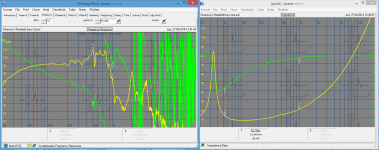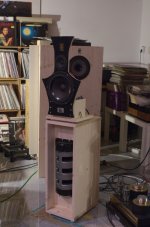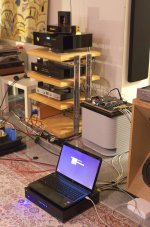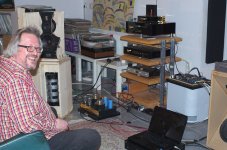Today Daniel visitet me and we programmed the DSP and set up the system the first time.
I tell you more soon.
I tell you more soon.
From what I recall, performing a nearfield measurement on a dipole merely shows you what the drivers natural roll off is without the dipole cancellation added in.
In other words this is how you ascertain what EQ to provide as a way of modifying the system Q towards something more desirable. For example if you used bass drivers with a Q of 0.3, you would probably want to LT it to get you up to a Q of 0.5-0.7.
Once you've done this you then need to either measure, or model, the effects of dipole cancellation and EQ that on top of the previous system Q modification.
You may already know this, but from your post above it seemed like you were expecting that one bit of EQ to sort out the bass response in room. It wont.
In other words this is how you ascertain what EQ to provide as a way of modifying the system Q towards something more desirable. For example if you used bass drivers with a Q of 0.3, you would probably want to LT it to get you up to a Q of 0.5-0.7.
Once you've done this you then need to either measure, or model, the effects of dipole cancellation and EQ that on top of the previous system Q modification.
You may already know this, but from your post above it seemed like you were expecting that one bit of EQ to sort out the bass response in room. It wont.
We made a first listen today and the system sure needs finetuning.
To my surprise the bass sounded just fine but there was a certain honk in the midrange that was a bit annoying.
Daniel had to leave early so we had maybe one hour to make some more experiments.
What was obvious was this " disappearing act ".
You really do not hear the location of the drivers.
I learn now how to programm the DSP myself. I also will make measurements outdoors and in an unechoic chamber.
This system has many ways of freedom you know.
To my surprise the bass sounded just fine but there was a certain honk in the midrange that was a bit annoying.
Daniel had to leave early so we had maybe one hour to make some more experiments.
What was obvious was this " disappearing act ".
You really do not hear the location of the drivers.
I learn now how to programm the DSP myself. I also will make measurements outdoors and in an unechoic chamber.
This system has many ways of freedom you know.
A few hours and some adjustments later it starts to get really fascinating.
The woofer was somewhat to loud, so was the tweeter. I am supplying the digital section with a battery now.
Tonal balance is much better now.
The woofer was somewhat to loud, so was the tweeter. I am supplying the digital section with a battery now.
Tonal balance is much better now.
Pardon my inexperience but why is a signal processor necessary with this speaker? Is it a result of the drivers chosen or is it the open baffle design itself?
Well, it is obviously not necessary to go the DSP route with this speakers, however this is a bit of an experiment 😀
We want to achieve a linear phase EQ an hence the DSP.
Please find attached some pictures of our first session. The dsp system + amp + speaker is now running and Joachim can do the fine tuning. Maybe he needs to do the whole procedure agan since on monday it was a bit quick'n'dirty 😱
We are using IIR filters in a first step to EQ and lowpass/highpass the single speakers. FIR filters calculated with RePhase perform the phase corrections to achieve linear phase behaviour. This saves taps which are somewhat limited on the miniSHARC.
kind regards, Daniel
We want to achieve a linear phase EQ an hence the DSP.
Please find attached some pictures of our first session. The dsp system + amp + speaker is now running and Joachim can do the fine tuning. Maybe he needs to do the whole procedure agan since on monday it was a bit quick'n'dirty 😱
We are using IIR filters in a first step to EQ and lowpass/highpass the single speakers. FIR filters calculated with RePhase perform the phase corrections to achieve linear phase behaviour. This saves taps which are somewhat limited on the miniSHARC.
kind regards, Daniel
Attachments
Hey Joachim, do you think that baffle shape adds something? From the little research I've done the rule of thumb is 2 to 2 1/2 times the width of the largest diameter for OB. The reason I ask is I'm thinking of using a 6" driver for the lower midrange and was wondering if I should scale it down or use a more conventional baffle.
Last edited:
I think the LX is made after the " Less is More " principle.
Linkwitzt told me that he arived at the shape by experiment. As fas as i can tell it gives a better null off axis and up to high frequencies.
Linkwitzt told me that he arived at the shape by experiment. As fas as i can tell it gives a better null off axis and up to high frequencies.
Thanks Joachim. I bought a pair of 6" woofers and have a pair of Vifa Pl11's for the upper midrange. For the tweeters I have some Morel domes. This will be my first open baffle so its a low buck foray. I found a thread dedicated to the baffle design but I was curious to hear you're opinion.
Kevin
Kevin
What I really want to know is what about that crazy woofer? Do you like it better than SL's pair?
Joachim , can you please update us on the status of this project?
Are you still developing this system?
Are you still developing this system?
Yes, i do. It is working but i have not learned to program the DSP good enough so far.
No time because of the High End fair in Munich this year.
I will bring the speaker to the Frickelfest ( a German DIY festival ) where i will work with Curryman on the final tuning. As is the speaker throws a tremendoes stage but there is still something wrong in the midrange i would like to ameliorate.
It sounds like a rather unpleasant honk. Worce on female then on male voice so i asume it is the upper midrange.
No time because of the High End fair in Munich this year.
I will bring the speaker to the Frickelfest ( a German DIY festival ) where i will work with Curryman on the final tuning. As is the speaker throws a tremendoes stage but there is still something wrong in the midrange i would like to ameliorate.
It sounds like a rather unpleasant honk. Worce on female then on male voice so i asume it is the upper midrange.
Thanks. I'll be following this thread with great interest.
Yes, i do. It is working but i have not learned to program the DSP good enough so far.
No time because of the High End fair in Munich this year.
I will bring the speaker to the Frickelfest ( a German DIY festival ) where i will work with Curryman on the final tuning. As is the speaker throws a tremendoes stage but there is still something wrong in the midrange i would like to ameliorate.
It sounds like a rather unpleasant honk. Worce on female then on male voice so i asume it is the upper midrange.
- Status
- Not open for further replies.
- Home
- Vendor's Bazaar
- Extreme Open Baffle Active Speaker inspired by Linkwitz LX521




